
Svetlana Rey / Shutterstock.com
It sounds like a contradiction in terms: Training a cat?
It is true that cats have an independent nature and are not as trainable as other types of pets, like dogs and horses. However, some cat breeds are known for being receptive to training. (And knowing cats, one could argue: Are we really training them, or are they training us?)
You can train some cats to do tricks like play fetch, or do functional tasks like sit, use a pet door to the outside, use a water fountain, and even walk on a leash. Admittedly, though, not all individual cats will tolerate training for these kinds of activities – I’ve had a few who would cop a cattitude and flat-out refuse – and some breeds are easier to train than others.
Here are eight of our favorite cat breeds that are easiest to train.
#1 Abyssinian

lightman_pic / Shutterstock.com
This gorgeous, sleek cat with brownish ticked fur is known for being playful, extroverted, energetic and highly intelligent – all traits that make the Abyssinian one of the most trainable cat breeds. Many Abyssinian owners report that their felines enjoy playing fetch, walking on a leash, and even learning cat tricks like jumping stunts on cue. Training them to do tricks stimulates their brain, and that is a driving force for the “Aby” – which some call the “Abysillian,” because these cats are so silly and impish. They are eager to please, especially if you offer them treats while training.
#2 Somali

Couperfield / Shutterstock.com
This relative of the shorthaired Abyssinian, which has the same exquisite ticked fur but medium-length and flowing, has its cousin’s manic energy, playful spirit, curiosity, and clever intelligence. Many Somali owners report playing games with their felines like fetch, and even hide and seek. These cats are highly curious, eager to get involved with what’s happening in their environment, and a bit mischievous.
#3 Turkish Van

Lea Rae / Shutterstock.com
These silky, athletic cats are energetic athletes and very prone to mischief, so they are eager to play games. With their rough-and-tumble nature and love of climbing, playing and exploring, the brainy Turkish Van is known for being open to training and quick to learn games like playing fetch. Some owners will swear that their Turkish Van can learn to do anything physically possible for a cat, with proper patience. Pair that personality with cashmere-like fur, and this quirky, fun feline can be your pet and student.
#4 American Shorthair

Apisit Hrpp / Shutterstock.com
This gorgeous cat – which comes in all colors, including the distinctive silver and black tabby swirls – is easy to train because the American Shorthair responds well to positive reinforcement. The breed, which has a rounded face and a lustrous coat, also is known for being calm and easygoing, traits that make them more trainable. The American Shorthair loves challenging games and is a great problem solver. Many owners of this breed take their cats for walks on leashes!
#5 Bengal

antibydni / Shutterstock.com
This exotic-looking spotted cat is descended from the Asian Leopard Cat, and retains the wild look and the playful, exploratory, energetic traits of their ancestors. Beautiful Bengals love interactive play with their humans, so expect lots of fun and games. They are among the most intelligent cat breeds, learn quickly, and have a doglike eagerness to please their people. And training Bengals to do tricks gives them a good outlet for their mischievous tendencies.
#6 Siamese
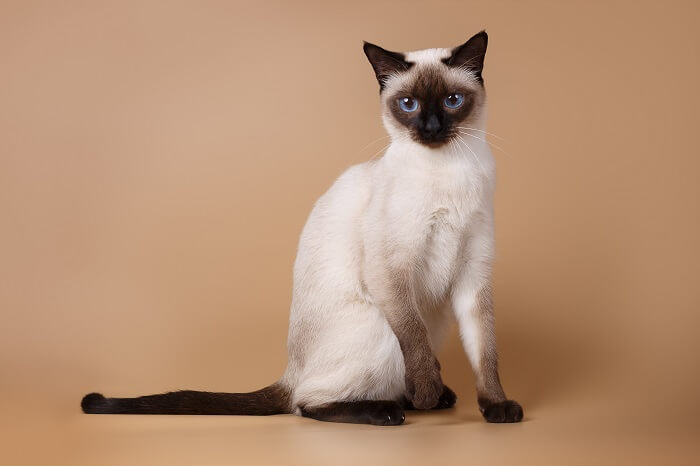
Altsva / Shutterstock.com
If you have one of these sleek, blue-eyed beauties with colored points, you have not only a fiercely loyal feline companion, but one that is trainable. Siamese cats want to be with their owners all the time, and they will really dig the attention they get when you teach them tricks like playing fetch. Your “Meezer” also may be up for a walk on a leash. And with a reputation of being the most talkative breed, the Siamese will carry on meowing conversations with you during training.
#7 Japanese Bobtail

dien / Shutterstock.com
This breed with a short tail, silky fur and a spunky personality has a very high energy level and lots of “cattitude.” The Japanese Bobtail cats are loyal and loving, and don’t just love attention; they demand it! Japanese Bobtails will follow their people around, and they bring humans toys to play fetch. These friendly, smart felines will learn with praise and rewards, and both cat and human will benefit from the quality time.
#8 Maine Coon

Pixel-Shot / Shutterstock.com
This feline gentle giant with long, flowing locks of luxurious fur has a reputation for being easygoing, calm, resilient, intelligent, and adaptable to many different situations and people, which makes the cat good for training. Maine Coon cats are known for being tolerant of and fond of children, so your kids can join in on the fun of training sessions. The Maine Coon learns quickly. With treats, praise, and consistency, Maine Coons will learn from you as they love on you.
Tips for Training Cats
Now that you know the easiest cat breeds to train, just how do you train a cat? It’s easier than it seems, and the training will provide your cats with an outlet for all that energy that they can channel into indoor mischief out of boredom. Your cat will enjoy the training, and the time spent together will provide a bonding experience.
Here are some tips for how to train your cat:
- Get a clicker. These hand-held devices make a clicking sound when you push a button, and then give a treat. Your cat will associate the click with the reward.
- Have your cat work for food. (Hey, we humans have to!) Either give them a favorite food treat as reinforcement or do the training before their regular meal.
- Start with teaching your cat to sit, once you’ve found a reward. This is something your cat does often. Click and give a treat when the cat’s bum touches the ground.
- Add a signal, like a verbal or hand cue, that the cat will learn to associate with sitting or other behavior. This tells the cat a reward is coming if they follow your lead.
- Keep sessions short. Cats have short attention spans. And have fun!
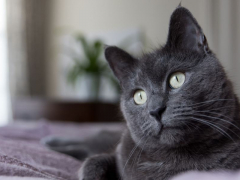
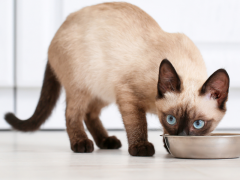
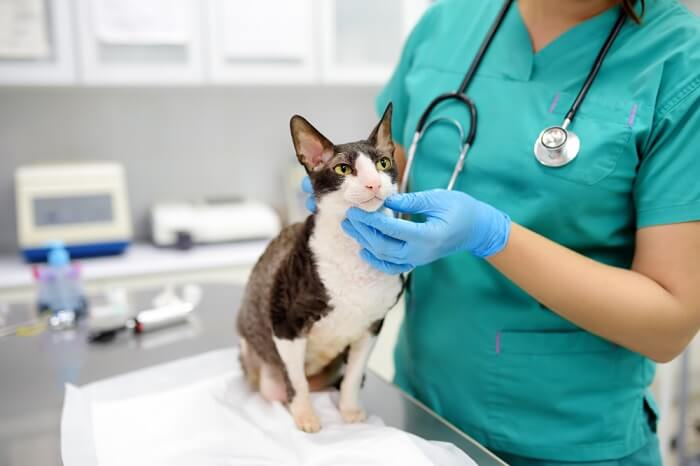
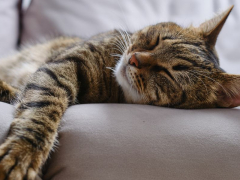
I’m sorry, but your failure to include Burmese cats in you list of trainable cats puts your entire list in question. I have raised and trained many animal species, from horses and dogs, to cats and rats. The primary trait in all species that separates the easily trainable from the difficult to train is that the animal must pay attention to the trainer. I have owned and spent significant time with cats of many of your listed breeds. Several are known for their independence and lack of attachment to humans. Burmese are extremely devoted to humans and choose to spend most of their waking hours involved in their humans activities. As a result. Burmese are extremely intelligent and trainable, definitely superior to Abyssinans, Somalis, Siamese or Japanese Bobtails, all of which I have owned, shown or with which I have spent significant time.
I too have been the proud owner, (if such that term can be applied to anyone sharing their lives with any cat breed out there lol), of an absolutely divinely gorgeous Female Burmese who was glorious even to just see, let alone interact with. I do agree their list was grossly lacking by omitting these wonderfully companionable felines with their quick responsive wit, a somewhat longer attention span in most cases, & their absolute drive to please their loving companions. I’ve owned some pretty fantastic learners over the many years of having cats, which is always a learning experience as no 2 cats ever sport the same precise “Cattitude”, but none who could ever hold a candle to her many tricks , but more importantly her unusual, nearly self taught mannerisms & regular daily jobs & duties that took very little training on my part or that of my family members & a large quantity of her own choice to show her affectionate nature through sharing her amazing abilities with my family, however, expressly for my benefit which you could easily see gave her immense pleasure & gratification earning my praises.
As for leash training, that was never a consideration that crossed my mind! Would she, if asked allow me to put her on a leash & walk with a refined ladylike manner, definitely even though I could see she felt it was something of a lowering experience for someone of her nature who, never once in all of her roughly 15 years, ever even made the least attempt to wander from my side regardless the provocation, one of her numerous self taught mannerisms BTW, she simply didn’t want to stray off like that, however she would concede to my “very strange” request. She could & would be very playful whenever the mood struck her & she saw I was happy to join in, but never to the point of becoming a pest in her insistence, but one of my very favorite moments I was blessed to share with her generally at some point in time every day or evening was when she would sit quietly until invited onto my lap & into my arms, & given the nod gracefully hop up into my lap, standing up on hind legs to place one paw lovingly on each of my shoulders & nuzzle my neck while she in turn received her own much enjoyed snuggles, caresses & loving & lavish pets, hugs & affectionate treatment. However she let it be immediately known should the need for me to prematurely try to rise before she felt she had been satisfactorily attended & allowed to attend me in kind & was ready to allow me to get away with cutting our sessions short by very quietly & discreetly sinking the tips of her lovely & seriously sharp claws into the tops of my shoulders for just the short few seconds to see her displeasure had been registered by me.
So yes I wholeheartedly must agree their list is something less than complete without the inclusion of the wonderfully wise & perfectly desirable abilities to learn & achieve anything & everything reasonably requested of them in rapid time. So while their list is, er, adequate as far as it goes they’re doing the Burmese a serious injustice by not placing them at the top of their list!!